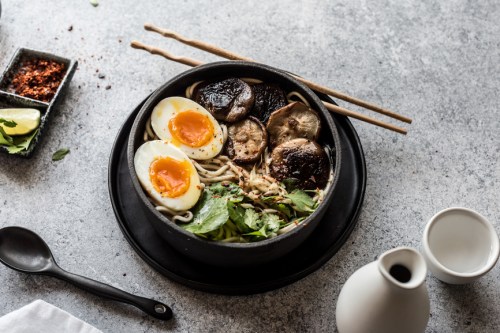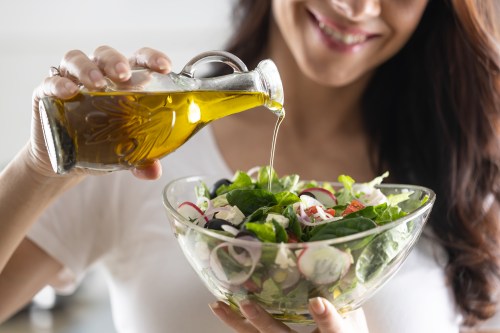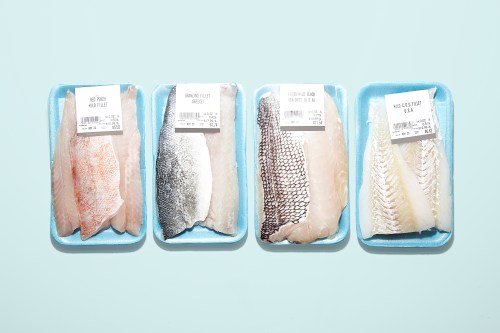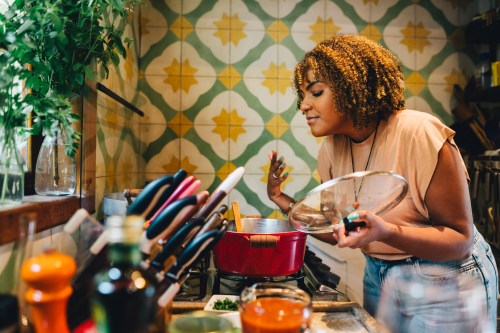Our editors independently select these products. Making a purchase through our links may earn Well+Good a commission
Just like your most trusted strapless bra that’s been around since the time NSYNC posters hung around your bedroom walls, it seems like we just can’t do away with those near-and-dear kitchen tools that have been supporting us for ages. In my mom’s kitchen, it’s her old pair of tongs that have been through it all—like that time she burnt curried chicken thighs to a crisp and attempted to “salvage” them by dissecting each one using (you guessed it) her tongs.
Experts in This Article
Maori Murota is a Japanese cookbook author.
Pretty much an extension of your arm—as chefs would describe their go-to trusty knife—any beloved kitchen tool can help expedite your cooking process and quickly become a multifunctionality culinary workhorse. Basically, it does it all. In the case of Maori Murota, the author of the international bestseller Tokyo Cult Recipes and her newest cookbook, Simply Japanese: 100 Authentic Recipes for Easy Home Cooking (which comes out in September), there’s one cooking tool she simply could never live without: her hashi, aka her favorite chopsticks for cooking.
Murota’s new book features 100 authentic and simple Japanese-inspired recipes, many of which—if not all—she used said chopsticks to make. So, what makes this simple cooking tool one of her absolute musts? Read on to learn the many ways Murota uses chopsticks to execute different cooking techniques, the history behind the tool, and her favorite recipe from her new book (that’s even easier to nail with the help of her trusted hashi, natch). After all, don’t we all want to eat—and cook—like some of the longest-living people in the world?
How hashi can transform your cooking skills
Like the rest of us, Murota spent a *lot* of time in her home during the pandemic lockdown. This time, she says, helped her reevaluate her relationship with cooking and forced her to explore alternative ways to make some of her favorite Japanese recipes using the ingredients she could get her hands on locally. As a result, she unsurprisingly learned to perfect making several Japanese staples—like noodles for ramen and udon, gyoza wrappers, tofu, and fermented pickled foods—entirely from scratch.
But long before Murota spent endless hours in her kitchen researching and developing her new book, she always reached for her hashi when preparing to cook any of her go-to recipes. Like my mom’s kitchen tongs, chopsticks for her are much more than a pair of equal-length sticks or eating utensils. Rather, they are her must-have multipurpose gadget that do it all; when Murota’s in the kitchen, she has her hashi in hand.
“I thought about many things, but if I have to choose one, it’s hashi,” says Murota. “These two sticks of bamboo or wood can do anything. Mix, whisk, flip, stir, and cut. Basically, I only need hashi and a knife to cook. I flip my ingredients with hashi while they’re grilling. I use them to pick things in my pan to see how they’re cooked. I mix, cut, and eat with them, of course. I do everything with my hashi. They are an extension of my hand and my fingers. It’s really difficult for me to cook without them.” The simplicity and versatility of this tool is a huge time-saver when meal prepping and helps make her cleanup process virtually nonexistent, Murota adds.
Where did hashi (and chopsticks) originate, and what is their cultural significance?
According to Murota, hashi arrived in Japan about 1,400 years ago from China, where they’ve been used for more than 3,000 years. At first, chopsticks were used to handle sacred offerings to gods, which is something that’s still respected to this day, she explains. “We are educated not to play with hashi. [Instead, we] treat them with care and respect. It is a tool to handle sacred food that was created by nature, grown, and prepared by people. This tool is a precious thing,” Murota says, adding that in Japanese culture, it’s important to harbor deep appreciation for the objects (like chopsticks), nature, and people that help prepare and serve a meal.
How to pick the perfect chopsticks for cooking
Murota says that picking the perfect pair of chopsticks comes down to three key things: what you’ll be using them for, their material, and their ability to withstand heat. For starters, she recommends reserving lacquered chopsticks only for eating and avoiding them when cooking, as they don’t withstand heat well and can burn, melt, or contaminate food.
Next, Murota says to look for sai-bashi, aka extra long chopsticks meant for cooking that can be anywhere between 30 to 50 centimeters long. This length helps keep your hands safe and away from the hot cooking surface. Although Murota shops for her chopsticks in Japan, you can find similar options like this pair on Amazon.
What’s the best thing to cook with chopsticks?
At the start of conceptualizing her new book, Murota included more fish and meat recipes, but as time went on and she spent more time away from Japan, she began gravitating toward more plant-based foods. The final version of Simply Japanese is primarily vegan-friendly, and any recipe that is not can easily be adapted to swap in plant-based ingredients.
One of Murota’s favorite recipes using her chopsticks is agebitashi, which is made of marinated and fried vegetables, like eggplant and mushrooms. For the dish, she uses her hashi to turn the veggies as they deep-fry to make sure they’re evenly-cooked to perfection. Plus, she says you can use chopsticks (like fancy restaurants use tweezers) to carefully plate and position the food for added presentation points. Murota likes to refer to the tool as an extension of her fingertips that helps her make precise and delicate movements as she serves her creations. Find Murota’s delicious agebitashi recipe from Simply Japanese below, and test out your chopstick cooking skills as you go.
Japanese-style fried and marinated vegetable (agebitashi) recipe
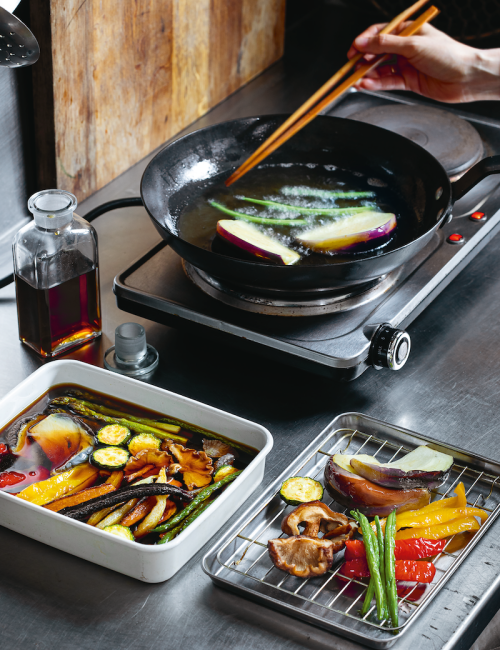
Yields 4 servings
Ingredients1 eggplantSalt, to taste12 green beans4 large fresh shiitake mushrooms2 small carrots1 zucchini1 small red bell pepper1 small yellow bell pepperOil, for frying
For the marinade:7 ounces mentsuyu2 cups water7 ounces rice vinegar
1. Clean all the vegetables. Cut the eggplant into large pieces. Soak in a container of salted water for five minutes. Drain and pat dry. Cut the stem end off the beans (keep the end with the pointy tip). Cut the shiitake mushrooms in half and trim the end of the stem. Cut the carrots in half lengthwise, the zucchini into half-inch rounds, and the peppers into eighths after removing the seeds.
2. Mix the marinade ingredients together in a large airtight container. Heat an inch (or slightly more) depth of oil to 170°C (340°F) in a deep frying pan. Fry all the vegetables in several batches, drain, and mix with the marinade while warm. Marinate for at least an hour before eating. This dish is even better prepared the day before because the vegetables then have time to fully absorb the umami of the mentsuyu overnight.
3. Serve with rice or pour the vegetables and sauce over fresh somen noodles for the perfect easy summer meal. Agebitashi will keep for three days in the refrigerator.
Vegan version: Replace the mentsuyu with mentsuyu shojin.
Sign Up for Our Daily Newsletter
Get all the latest in wellness, trends, food, fitness, beauty, and more delivered right to your inbox.
Got it, you've been added to our email list.
